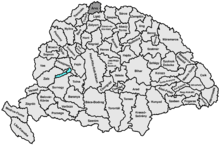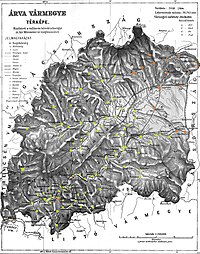| Revision as of 21:45, 14 September 2016 editKIENGIR (talk | contribs)Extended confirmed users, Pending changes reviewers25,154 editsNo edit summary← Previous edit | Revision as of 08:54, 15 September 2016 edit undoNorden1990 (talk | contribs)Extended confirmed users50,659 edits Undid revision 739469364 by KIENGIR (talk) current names are also importantNext edit → | ||
| Line 27: | Line 27: | ||
| ==Geography== | ==Geography== | ||
| ] | ] | ||
| In the past Árva county shared borders with the ]n land ] and the Hungarian counties ], ] and ]. The county's territory was situated along the ] |
In the past Árva county shared borders with the ]n land ] and the Hungarian counties ] (Trenčín), ] (Turiec) and ] (Liptov). The county's territory was situated along the ] between ] and the ]. Its area was 2,019 km² around 1910. Now the territory is divided between Poland and Slovakia. The main Polish town of Orava is ]. | ||
| ==Capitals== | ==Capitals== | ||
| The capital of the county was the ] |
The capital of the county was the ], then ] and since the late 17th century ]. | ||
| ==History== | ==History== | ||
Revision as of 08:54, 15 September 2016
"Árva" redirects here. For other uses, see Arva.| Árva County | |
|---|---|
| County of the Kingdom of Hungary | |
| 15th century–1920 | |
 Coat of arms
Coat of arms
| |
 | |
| Capital | Alsókubin |
| Area | |
| • 1910 | 2,019 km (780 sq mi) |
| Population | |
| • 1910 | 78,700 |
| History | |
| • Established | 15th century |
| • Treaty of Trianon | 4 June 1920 |
| Today part of | Slovakia, Poland |
| Dolný Kubín is the current name of the capital. | |
Árva (Slovak: Orava, Polish: Orawa, German: Arwa) was an administrative county (comitatus) of the Kingdom of Hungary. Its territory is now in northern Slovakia and southern Poland. Today, the Slovak name is only used as an informal designation of the corresponding territory (see Orava (region)).
Geography

In the past Árva county shared borders with the Austrian land Galicia and the Hungarian counties Trencsén (Trenčín), Turóc (Turiec) and Liptó (Liptov). The county's territory was situated along the Orava River between Zázrivá and the Tatra mountains. Its area was 2,019 km² around 1910. Now the territory is divided between Poland and Slovakia. The main Polish town of Orava is Jabłonka.
Capitals
The capital of the county was the Orava Castle, then Veličná and since the late 17th century Dolný Kubín.
History
Árva county as a Hungarian comitatus arose before the 15th century. In the aftermath of World War I, the area became part of newly formed Czechoslovakia, as recognized by the concerned states in the 1920 Treaty of Trianon. After a border dispute (treated in detail under Polish–Czechoslovak border conflicts) several villages in the north-east of the now defunct Árva county's territory were exchanged between Poland and Czechoslovakia.
During World War II, when Czechoslovakia was split temporarily, Orava was part of independent Slovakia. After World War II, Orava county was in Czechoslovakia again. In 1993, Czechoslovakia was split and Orava became part of Slovakia.
Demographics
In 1900, the county had a population of 85.009 people and was composed of the following linguistic communities:
Total:
- Slovak: 80,487 (94.7%)
- German: 2,127 (2.5%)
- Hungarian: 1,494 (1.8%)
- Ruthenian: 6 (0.0%)
- Romanian: 5 (0.0%)
- Croatian: 2 (0.0%)
- Serbian: 0 (0.0%)
- Other or unknown: 888 (1.0%)
According to the census of 1900, the county was composed of the following religious communities:
Total:
- Roman Catholic: 75,337 (88.6%)
- Lutheran: 6,936 (8.2%)
- Jewish: 2,648 (3.1%)
- Calvinist: 50 (0.1%)
- Greek Catholic: 19 (0.0%)
- Greek Orthodox: 13 (0.0%)
- Unitarian: 0 (0.0%)
- Other or unknown: 6 (0.0%)

In 1910, county had a population of 78,745 people and was composed of the following linguistic communities:
Total:
- Slovak: 59,096 (75.0%)
- Hungarian: 2,000 (2.5%)
- German: 1,518 (1.9%)
- Romanian: 8 (0.0%)
- Croatian: 1 (0.0%)
- Ruthenian: 1 (0.0%)
- Serbian: 1 (0.0%)
- Other or unknown (most of them Polish): 16,120 (20.5%)
According to the census of 1910, the county was composed of the following religious communities:
Total:
- Roman Catholic: 69,788 (88.6%)
- Lutheran: 6,674 (8.5%)
- Jewish: 2,205 (2.8%)
- Calvinist: 51 (0.0%)
- Greek Catholic: 18 (0.0%)
- Unitarianist: 5 (0.0%)
- Greek Orthodox: 4 (0.0%)
- Other or unknown: 0 (0.0%)
Districts

In the early 20th century, the districts and their capitals were:
| Districts (járás) | |
|---|---|
| District | Capital |
| Alsókubin | Alsókubin, SK Dolný Kubín |
| Námesztó | Námesztó, SK Námestovo |
| Trsztena | Trsztena, SK Trstená |
| Vár | Turdossin, SK Tvrdošín |
References
- "KlimoTheca :: Könyvtár". Kt.lib.pte.hu. Retrieved 2012-12-06.
- "KlimoTheca :: Könyvtár". Kt.lib.pte.hu. Retrieved 2012-12-06.
- "KlimoTheca :: Könyvtár". Kt.lib.pte.hu. Retrieved 2012-06-19.
- "KlimoTheca :: Könyvtár". Kt.lib.pte.hu. Retrieved 2012-06-19.
External links
- Template:Sk icon http://www.orava.sk
- Template:Pl icon http://skansen.nowotarski.pl Orawa Ethnographic Park
- http://www.oravafoto.com
- Template:Sk icon http://www.namestovo-orava.webnode.sk
